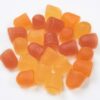
Turmeric for Back Pain: Back pain is one of the most repeated excuses for missing a day of work. According to global back pain statistics, the population worldwide suffers from lower back pain. About 540 million people worldwide are affected by back pain at any time. It is predicted that 4 in 10 office workers will undergo lower back pain inflammation.

Current non-surgical treatments for back pain conditions are neither effective nor safe. As a non-toxic natural product, curcumin in turmeric has a premium anti-inflammatory profile that reduces back pain and inflammation. Radicular back pain is one of the common causes of lower back pain. Researchers observed that curcumin alleviates radiculopathy by reducing neuroinflammation, oxidative stress, and nociceptive factors. This article will delve into the science behind using turmeric for back pain. We’ll discuss whether research confirms this effect, the dosage shown to have a beneficial impact, and any side effects that you should look out for.
Curcumin is a natural substance extracted from the root of turmeric plants. It has been used in Indian medicine for thousands of years. Still, modern science has only recently begun to understand how it works and how it might help treat various conditions like arthritis, heart disease, back pain, and even cancer.
What causes Back Pain?
Sitting too much can lead to debilitating pain in your lower back and other parts of your body because it causes poor posture and tight muscles. Sitting also puts pressure on discs between vertebrae in the spine, which can cause them to degenerate prematurely. Also, it restricts blood flow through veins while disturbing proper nerve function. The most common cause of back problems is muscle or ligament damage. Torn or ripped tissues can inflame, resulting in pain and less movement. Muscle strains are also common causes of back pain that can result from overstretching and pulling muscles during exercise. Historically, turmeric (together with its active ingredient “curcumin”) has been known for its anti-inflammatory effects. But do these ingredients truly work – and can they support the muscle tissue harm linked to back pain?

To assess the anti-inflammatory properties of turmeric, patients with rheumatoid arthritis were dosed with a standard pharmaceutical anti-inflammatory, the bioactive ingredient in turmeric (curcumin), or a combination of the two. During observation, researchers recorded that all three groups saw notable improvements. Perhaps more interestingly, the results showed that the turmeric curcumin group showed the highest progress percentage, even more than those taking the standard anti-inflammatory.
1. Science suggests curcumin could help treat back pain.
Curcumin in turmeric is a natural anti-inflammatory and has been shown to reduce pain and inflammation. The National Center for Complementary and Integrative Health (NCCIH) lists curcumin as a complementary approach for treating osteoarthritis. It may also help with back pain due to its anti-inflammatory properties, which inhibit the production of prostaglandins that contribute to joint inflammation. Some studies have even found that it works better than ibuprofen for reducing acute pain associated with exercise or injury.
2. Curcumin in Turmeric is safe and effective compared with other treatments.
Turmeric curcumin is an effective treatment for back pain. It is more effective than traditional treatments, such as medication and surgery, without the side effects or risks associated with these other methods. It is safe because it’s not addictive like some pain medications are (such as opioids) or expensive, like many treatments that require surgery or injections (like epidurals). If you’re looking to ease your back pain without relying on drugs, surgery, or risky procedures, then switching out allopathic approaches with curcumin may be exactly what you need!
3. Turmeric: A natural way to relieve your back pain.
Most people have heard of curcumin, but many don’t know exactly what it is. Curcumin is the ingredient in turmeric spice, which our ancestors used as a cooking ingredient and herbal medicine for its anti-inflammatory properties. It can come in capsules or liquid extract (the liquid form is more concentrated). Recommended turmeric dosage of 500mg of curcumin twice daily with food to avoid stomach upset and maximize absorption into the bloodstream.
IS TAKING TURMERIC SAFE FOR BACK PAIN?
Turmeric has been used for both culinary and medicinal pursuits for centuries. Various studies in recent years have used doses of 1125mg-2500mg over an extended period without noting any issues. During this time, no adverse cases from long-term use. Even more extreme, one thorough analysis gave participants an astonishing 8000mg of turmeric per day for three months. Once again, participants showed no symptoms of toxicity. Even in large doses or when taken over a long time, the side effects are mainly on par with volunteers consuming a placebo. Consequently, turmeric owns respect within scientific circles for its high safety profile.
HOW TO USE TURMERIC FOR BACK PAIN?
Rigorous studies have shown that turmeric positively impacts inflammation, but there is an issue. Firstly, it isn’t alone, which is wholesome; instead, a unique chemical (curcumin) is present in it. The amount of curcumin present within organic turmeric powder can vary greatly. Therefore, it is considerably safer to assess the curcumin dose than turmeric.
Secondly:
The liver metabolizes curcumin very fast. This means it filters out the body quickly, and absorption is low. The result is minimal or no beneficial effects.
For example, a recent study that gave participants 4-5 grams of curcumin showed that levels peaked between one and two hours after consumption and “fell rapidly” thereon. Luckily, there is a solution to this apparently bad news about curcumin’s absorption. Combining curcumin with a second ingredient, “piperine,” increases its bioavailability. Piperine is the active ingredient in some black pepper varieties, so a piperine/curcumin complex generally induces the most potent results and long-term health effects.
Turmeric Dosage
The average dose of roughly 200-600mg of curcumin seems beneficial based on former and later studies. This is much equal to around 2 grams of ordinary turmeric powder. As we have seen, however, taking higher doses is unlikely to cause ill results, so some people with unbearable back pain settle to consume more.
Our Turmeric curcumin with Ginger and BioPerine Capsules contain the exact amount of curcumin extract, so you can really pack a punch.
Your risk of developing back pain may increase if you are overweight.
It’s important to note that curcumin is less effective in people who are overweight because it has a higher risk of stored fat cells. If you are overweight or have high blood sugar levels, the curcumin you take may not absorb so quickly.
However, there are other options available if curcumin isn’t working for your back pain:
- Turmeric tea – this can help to lower inflammation in your joints and muscles as well as boost your immune system. If possible, use organic turmeric powder rather than ground turmeric root to get the active ingredients inside. Remember that fresh turmeric is more potent than dried. So start with small amounts if necessary when making this, don’t at home.
- Ginger tea and ginger water contain anti-inflammatory compounds called gingerols, which also play a role in reducing swelling. Also, it lowers inflammation associated with arthritis symptoms such as joint pain and stiffness.
- Either you can try recipes with turmeric for an anti-inflammatory boost.
Top Tip: Please Bother!
Your shoes should fit properly so they don’t rub against your foot and cause corns or blisters (which are uncomfortable enough on their own). However, they can cause more severe problems, such as backaches and knee injuries, when they don’t fit properly.
First, you must ensure that the shoe is a manageable size for your feet by measuring them in inches before shopping for new ones at the store. If possible, bring along a pair of socks with you that you intend on wearing so that you get an accurate idea of how much room there will be between them and the sides of your feet once inside; this will help ensure that nothing pinches when worn over time because there wasn’t enough room available when trying them on initially!
WRAP UP:
Curcumin is an option worth considering if you’re looking for a natural, safe, and effective way to treat your back pain. The evidence suggests that it can help relieve pain symptoms and reduce inflammation in the body. It is also a good choice if you don’t want to take prescription medications due to side effects or because they aren’t safer. However, research needs to discover more before we know precisely how effective curcumin is at treating back pain specifically—and whether it will work for everyone suffering from this condition!
REFERENCES
Xiao L, Ding M, Fernandez A, Zhao P, Jin L, Li X. Curcumin alleviates lumbar radiculopathy by reducing neuroinflammation, oxidative stress and nociceptive factors. https://www.ncbi.nlm.nih.gov/pmc/articles/PMC5521990/ Eur Cell Mater. 2017 May 9;33:279-293. doi: 10.22203/eCM.v033a21. PMID: 28485773; PMCID: PMC5521990.
Hewlings SJ, Kalman DS. Curcumin: A Review of Its Effects on Human Health. Foods. https://www.ncbi.nlm.nih.gov/pmc/articles/PMC5664031/ 2017 Oct 22;6(10):92. doi: 10.3390/foods6100092. PMID: 29065496; PMCID: PMC5664031.
Rudrappa GH, Chakravarthi PT, Benny IR. Efficacy of high-dissolution turmeric-sesame formulation for pain relief in adult subjects with acute musculoskeletal pain compared to acetaminophen: A randomized controlled study. https://www.ncbi.nlm.nih.gov/pmc/articles/PMC7360261/ Medicine (Baltimore). 2020 Jul 10;99(28):e20373. doi: 10.1097/MD.0000000000020373. PMID: 32664057; PMCID: PMC7360261.
Sharifi-Rad J, Rayess YE, Rizk AA, Sadaka C, Zgheib R, Zam W, Sestito S, Rapposelli S, Neffe-Skocińska K, Zielińska D, Salehi B, Setzer WN, Dosoky NS, Taheri Y, El Beyrouthy M, Martorell M, Ostrander EA, Suleria HAR, Cho WC, Maroyi A, Martins N. Turmeric and Its Major Compound Curcumin on Health: Bioactive Effects and Safety Profiles for Food, Pharmaceutical, Biotechnological and Medicinal Applications. https://www.ncbi.nlm.nih.gov/pmc/articles/PMC7522354/ Front Pharmacol. 2020 Sep 15;11:01021. doi: 10.3389/fphar.2020.01021. PMID: 33041781; PMCID: PMC7522354.
Sanivarapu R, Vallabhaneni V, Verma V. The Potential of Curcumin in Treatment of Spinal Cord Injury. https://www.ncbi.nlm.nih.gov/pmc/articles/PMC4889828/ Neurol Res Int. 2016;2016:9468193. doi: 10.1155/2016/9468193. Epub 2016 May 19. PMID: 27298735; PMCID: PMC4889828.
Hasriadi, Dasuni Wasana PW, Vajragupta O, Rojsitthisak P, Towiwat P. Mechanistic Insight into the Effects of Curcumin on Neuroinflammation-Driven Chronic Pain. https://www.ncbi.nlm.nih.gov/pmc/articles/PMC8397941/ Pharmaceuticals (Basel). 2021 Aug 7;14(8):777. doi: 10.3390/ph14080777. PMID: 34451874; PMCID: PMC8397941.
Taiba Tariq
Taiba Tariq is a healthcare nutrition hobbyist, enthusiastic about researching healthcare & skincare news while analyzing the latest and science-backed evidence about nutrition, skin care, and supplements. She wants to help people regain their beauty, health, and well-being through natural means.
all author posts




